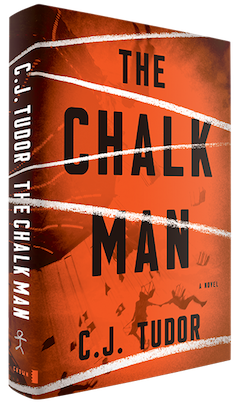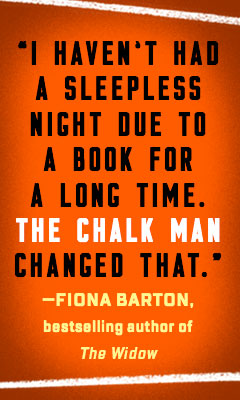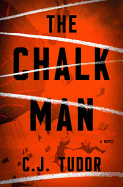The Chalk Man
by C.J. Tudor
C.J. Tudor wastes no time cutting to the creepiness in her captivating novel, The Chalk Man. The thriller opens with:
"The girl's head rested on a small pile of orange and brown leaves."
Not chilling enough? How about:
"Someone approached. They knelt down beside the unseeing girl. Their hands gently caressed her hair and stroked her cold cheek, fingers trembling with anticipation. Then they lifted up her head, dusted off a few leaves that clung to the ragged edges of her neck, and placed it carefully in a bag."
The prologue ends with "the girl in the woods was never put together again."
Are you scared yet?
The Chalk Man centers around Eddie and his group of friends, and alternates between two timelines--1986 and 2016. In the earlier time, Eddie is 12, on the cusp of puberty like his buddies, including the only girl in the group, Nicky, who makes Eddie feel "really hungry and... a bit sick" whenever he sees her. They spend their days biking around their English village, going to the fair and searching for adventure.
After Fat Gav, one of the boys, receives a bucket of colored chalks for his birthday, the friends devise a secret mode of communication. Each of them is assigned a color, and they draw chalk men in one another's driveways to convey coded messages such as meet at the playground now.
One day the gang gathers at the playground, each thinking one of the others summoned them with chalk instructions, but they all deny having done so. When they follow the chalk men pointing into the woods, they make a gruesome discovery: the dismembered body of a local girl. And it's not their sole encounter with death that summer.
In 2016, Ed is a teacher living in his childhood home, which he inherited. He has a female tenant, Chloe, on whom he nurses a mild crush, but otherwise Ed is single and doesn't have much of a social life. He seems fairly resigned to his mundane existence--until he receives a letter from an unknown sender containing only a chalk figure. Also, his old friend Mickey is coming back to town and wants to meet with Ed. Mickey is interested in writing a book about the friends' past, claiming he knows who killed the girl in the woods.
Soon Ed starts having nightmares, waking up to chalk men scribbled around his home, both outside and in. He realizes the dead won't stay buried unless he confronts them head-on.
The Chalk Man is a remarkable achievement, made even more impressive by the fact it's a debut. Tudor is a master conjurer of thrills, crafting tight scenes that make the skin crawl in a fun way, without crossing into gory territory. It's like walking through a haunted house at a carnival--there's an unrelenting sense of unease and scary stuff happens, but you know you're in safe hands. Tudor's style is so cinematic, readers will not only vividly envision everything she's describing, they'll hear the ominous music on the soundtrack. And many chapters end on a note that makes it impossible to stop reading.
Tudor also infuses her story with heart and the pang of lost love, making her novel even more satisfying. The author nails the male point of view, of both Eddie the boy and Ed the adult. Even without the chapter headings indicating 1986 or 2016, it's clear which voice is narrating--the boy going through life-changing events whose full impact he hasn't grasped, or the man still trying to move past those events 30 years later.
One of the most memorable characters is Mr. Halloran, aka the Pale Man, a mysterious albino teacher at Eddie's school. His nature is gentle and he comes to the rescue of more than one kid who's hurt or bullied, but why does he seem so forlorn, and what was the nature of his relationship with the dead girl? Tudor keeps readers guessing, and when she finally reveals the truth, it's quietly devastating.
It's not all chills and darkness, though. Tudor observes life with deadpan humor. In 2016, Ed's friend Mike "works for an advertising agency--the type that has unnecessary umlauts in its name and an aversion to capital letters." When Ed visits a nursing home and sees an old episode of Diagnosis Murder on the TV, he thinks, "[I]f you hadn't lost your mind before you came here, watching Dick Van Dyke and his family hamming it up every day would probably send you over the edge."
Tudor won't send readers over the edge, though. She'll have them exactly where she wants them--on a creepy adventure that's enthralling until the final word. --Elyse Dinh-McCrillis








